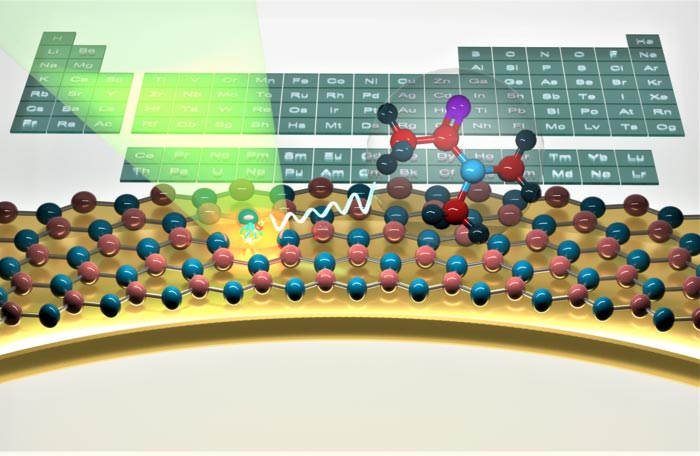Seeing clearly into a new realm

An artist's impression of a quantum microscope for study of chemical reactions and to identify molecular origin.
Credit: Dr Mehran Kianinia
Researchers prototype a new generation of quantum microscopy.
While quantum computing seems like the big-ticket item among the developing technologies based on the behaviour of matter and energy on the atomic and subatomic level, another direction promises to open a new door for scientific research itself – quantum microscopy.
With the advance of quantum technologies, new microscopy modalities are becoming possible – ones that can see electric currents, detect fluctuating magnetic fields, and even see single molecules on a surface.
A prototype of such a microscope, demonstrating high resolution sensitivity, has been developed by an Australian research team headed by Professor Igor Aharonovich of the University of Technology Sydney and Dr Jean-Philippe Tetienne of RMIT University. The team’s findings have now been published in Nature Physics.
The quantum microscope is based on atomic impurities, that following laser illumination, emit light that can be directly related to interesting physical quantities such as magnetic field, electric field or the chemical environment in proximity to the defect.
Professor Aharonovich said the ingenuity of the new approach was that, as opposed to the bulky crystals often employed for quantum sensing, the research team had utilised atomically thin layers, called hexagonal boron nitride (hBN).
“This van der Waals material – that is, made up of strongly bonded two-dimensional layers – can be made to be very thin and can conform to arbitrarily rough surfaces, thus enabling high resolution sensitivity,” Professor Aharonovich said.
“These properties led us to the idea of using ‘quantum-active’ hBN foils to perform quantum microscopy, which essentially is an imaging technique that utilises arrays of quantum sensors to create spatial maps of the quantities they are sensitive to,” Dr Tetienne said.
“Until now, quantum microscopy has been limited in its spatial resolution and flexibility of application by the interfacing issues inherent in using a bulky three-dimensional sensor. By instead utilising a van der Waals sensor, we hope to extend the utility of quantum microscopy into arenas that were previously inaccessible.”
To test the capabilities of the prototype, the team performed quantum sensing on a technologically relevant magnetic material – a flake of CrTe2, a van der Waals ferromagnet with a critical temperature just above room temperature.
The hBN based quantum microscope was able to image the magnetic domains of the ferromagnet, with nanoscale proximity to the sensor, and under ambient conditions – something that was believed to be impossible to date.
Moreover, utilising the unique properties of the hBN defects, a simultaneous temperature map was recorded, confirming that the microscope can be used to perform correlative imaging between the two quantities.
Lead authors for the Nature Physics paper, PhD students Alex Healey (University of Melbourne) and Sam Scholten (University of Melbourne), and early career researcher Tieshan Yang (UTS), said the van der Waals nature of the sensor had allowed the dual sensing of magnetic properties and temperature.
“Because it is very thin, not much heat is able to dissipate through it and any temperature distribution that exists is the same as if the sensor were not there,” they said. “What began as an experimental annoyance ended up being a hint towards a capability of our microscope that is unique among current alternatives.”
“There is a huge potential for this new generation of quantum microscopy,” UTS senior researcher Dr Mehran Kianinia said. “Not only can it operate at room temperature and provide simultaneous information on temperature, electric and magnetic fields, it can be seamlessly integrated into nanoscale devices and withstand very harsh environments, as hBN is a very rigid material.
“The main future applications include high resolution MRI (magnetic resonance imaging) and NMR (nuclear magnetic resonance) that can be used to study chemical reactions and identify molecular origins, as well as applications in space, defence and agriculture where remote sensing and imaging are key.”
The paper, “Quantum microscopy with van der Waals heterostructures”, is published in Nature Physics.
Journal: Nature Physics
DOI: 10.1038/s41567-022-01815-5
Method of Research: Experimental study
Subject of Research: Not applicable
Article Title: Quantum microscopy with van der Waals heterostructures
Article Publication Date: 7-Nov-2022
All latest news from the category: Physics and Astronomy
This area deals with the fundamental laws and building blocks of nature and how they interact, the properties and the behavior of matter, and research into space and time and their structures.
innovations-report provides in-depth reports and articles on subjects such as astrophysics, laser technologies, nuclear, quantum, particle and solid-state physics, nanotechnologies, planetary research and findings (Mars, Venus) and developments related to the Hubble Telescope.
Newest articles

First-of-its-kind study uses remote sensing to monitor plastic debris in rivers and lakes
Remote sensing creates a cost-effective solution to monitoring plastic pollution. A first-of-its-kind study from researchers at the University of Minnesota Twin Cities shows how remote sensing can help monitor and…

Laser-based artificial neuron mimics nerve cell functions at lightning speed
With a processing speed a billion times faster than nature, chip-based laser neuron could help advance AI tasks such as pattern recognition and sequence prediction. Researchers have developed a laser-based…

Optimising the processing of plastic waste
Just one look in the yellow bin reveals a colourful jumble of different types of plastic. However, the purer and more uniform plastic waste is, the easier it is to…


